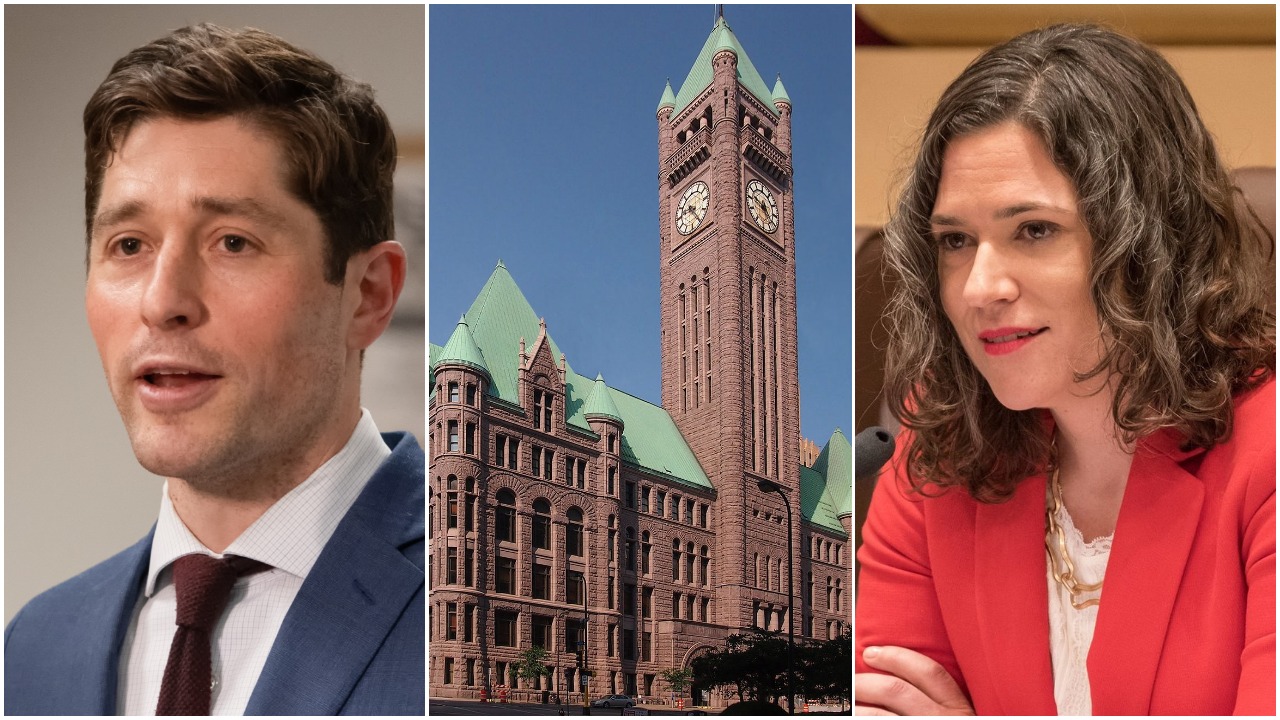The streets of Minneapolis are quieter than they were last summer, when buildings along Lake Street burned and police responded by “hunting” (their words) curfew-breakers.
But as the streets calmed somewhat, Minneapolis politics erupted. A previously obscure commission inserted itself into the middle of city politics, essentially pocket-vetoing a decision by the City Council. The police chief personally helped coordinate a stealth PR campaign to influence the city budget. A prominent pro-police activist waved a photo of a dead child at a press conference and blamed “defund rhetoric.” A cadre of long-time political insiders hid their involvement in multiple political committees, and may have broken campaign finance rules to do it. The City Council president and the mayor are locked in a not exactly cold, but maybe luke-warm war. One of the three charter amendments on the ballot would completely reshape the government, from the strong-council system the city has had for more than a century to a strong-mayor system.
Up and down the ballot, the city has divided into two factions on just about every issue and candidate. Since the murder of George Floyd, the political mechanism of the city has quivered under the tension like springs wound to their breaking point. Come Election Day, the machine will release and spring forward into whatever comes next. But the story of this election began long before 2020—in May 2012, when the Minneapolis City Council voted to approve the financing package for U.S. Bank Stadium.
The Downtown Council Gets Its Stadium
Though the Minnesota Vikings had threatened since 1999 to relocate if they didn’t get a new stadium, it wasn’t until 2012, with the support of Gov. Mark Dayton and Mayor R.T. Rybak, that a deal for the team’s new home was nearly finalized.
All that remained was for the Minneapolis City Council to approve the city’s share of the financing: a cool $150 million for initial construction, plus operating expenses. In return, the city would get an expanded tax base and the intangible benefits that come with hosting an NFL team.
Still, Minneapolitans were skeptical. At the state and local level, a coalition of interests pushing the stadium mobilized against that skepticism, largely behind closed doors. Star Tribune columnist Jon Tevlin described the deal as “transparent as the Berlin Wall.”
Take the Minneapolis city charter stipulation that stadium financing required a public referendum, Tevlin noted. Though the state legislature preempted that requirement to ease the deal along, the city attorney’s office produced a memo explaining that, even without the preemption, this stadium was exempt.
Tevlin pointed out that the memo, written by the city attorney and Deputy Attorney Peter Ginder, was based on faulty reasoning. (A Hennepin County judge would later agree.) But the memo apparently convinced Council Member Sandy Colvin Roy (whom Tevlin called “the crucial swing vote”) to vote for the deal. (Colvin Roy later said interactions with numerous professionals on the city staff made her swing the way she did.)
Cam Gordon has been the only non-DFLer on the City Council since he was elected in 2005, giving him and his policy aide, Robin Garwood, a unique perspective: inside City Hall but outside DFL drama.
“There were these council members from, you know, non-downtown parts of the city who were maneuvered and muscled and pushed in this Majority Whip kind of way to vote for this thing,” Garwood says.
Garwood wasn’t in those conversations, but he has a sense of what was said: “The governor and the legislature have worked on this deal, and they had to do a whole lot of wrangling, and we can't possibly be the body that kills it.” And: “We can't go so wacko-y over to the left and make such a big thing out of how progressive we are.” And a vague, perhaps unspoken, threat: “Or the state will keep hating us, and hurt us.”
Garwood also has a guess about some of the people whipping votes: Rybak, Dayton, Council President Barb Johnson, and what he called “the Downtown folks”: the Downtown Council, its allies, and its members, especially developers.
The Minneapolis Downtown Council is a business association working, as its mission statement says, “to promote the growth and development of the downtown area and its businesses.” It lists more than 400 members on its website, including five Fortune 500 companies, and surrounds itself with a web of associated organizations such as Green Minneapolis and the Downtown Improvement District.
In 2011, the Downtown Council released their 15-year plan for Minneapolis, with the stadium a lynchpin. Their two municipal lobbyists had been working on “economic development” and “sports stadium” for at least three years before the vote. The general contractor on the stadium project, Downtown Council member M.A. Mortensen, hired former City Council President Jackie Cherryhomes to lobby the city.
The project earned the support of seven council members: then-President Barb Johnson, Sandy Colvin Roy, Diane Hofstede, John Quincy, Kevin Reich, Don Samuels and Meg Tuthill.
“They were able to muscle the stadium deal through, even when some of the folks voting for it had good reason to know it would be very bad for them,” Garwood says.
“And then it immediately was.”
Stadium Blowback and Progressive Advances
Colvin Roy, the swing vote, dropped out of the 2013 race in June after she failed to receive the DFL endorsement. Diane Hofstede and Meg Tuthill were voted out in November, replaced by a pair of progressives: Jacob Frey and Lisa Bender. Don Samuels ran for mayor, but lost 3-1 to Betsy Hodges, who voted against the stadium deal as a council member.
Of course, the stadium vote wasn’t the only factor in the 2013 election. It was part of a larger dynamic that has reverberated through Minneapolis politics for decades. In 2017, the Star Tribune described it as “a civil war in the Minneapolis DFL, with complex and overlapping alliances, between establishment Democrats and a more liberal wing clamoring for change.”
Lefties working outside the DFL, and the local aftershocks of national events also played a role. Less than a year before the stadium vote, Occupy Wall Street overcame 60 years of American politics to un-dirty the word “socialism.” The summer before the 2013 elections, Minneapolis’s own offshoot, Occupy Homes, reached its zenith. Black Lives Matter first appeared as a hashtag just a few months before Minneapolis voted, but Black organizers in the Twin Cities were already coming together around a slew of racial justice issues, including the nature of policing.
All the overlapping waves lined up in 2013 and handed progressives a majority on the council—in theory anyway. Jacob Frey proved politically flexible, “He was trying to be on both sides. Left enough, but not quite when it mattered,” Garwood says. “He had a lot of connections to that big downtown money.”
When Elizabeth Glidden made a play for the council presidency, Frey backed the establishment candidate. Johnson retained the presidency, and mostly stymied Hodges’s agenda.
Still, popular pressure was enough to force concessions from the more conservative bloc, especially as the election neared. Johnson, who opposed a municipal minimum wage for years, voted for a $15 minimum wage ordinance months before the 2017 election. She lost anyway, to Phillipe Cunningham, who had been a senior policy aide for Hodges. (Johnson immediately shit-talked the municipal minimum wage in a Star Tribune interview.)
The same year, Jeremy Schroeder defeated Quincy, leaving Kevin Reich the only surviving council member who had voted for the stadium.
“A small minority was still mad at him about the stadium vote,” Schroeder says of Quincy. But more than that, according to Schroeder, Quincy ran as a “go along to get along” candidate in a year when, and a ward where, people wanted progressive leadership.
2017 wasn’t a progressive sweep. The establishment notched a win when Frey beat Hodges in the mayoral race. “Instead of the council putting the brakes on the mayor, it’s more the mayor putting the brakes on the council and working with, I would say, a structural minority of the council that is on the more sort of conservative side,” Garwood says.
Of course, politics doesn’t cut so cleanly. Garwood points out that R.T. Rybak was elected as a progressive, Council Member Lisa Goodman was so upset when the stadium deal passed that she cried despite being firmly in the establishment camp, and Betsy Hodges initially opposed the municipal minimum wage.
Still, a progressive faction has held a majority on the council for four years in a city with a strong council system, and enacted policies including a ban on facial recognition technology, an overhaul of the city’s wage theft protections, and a handful of renter protections. (Full disclosure: my wife is one of two co-executive directors of Inquilinxs Unidxs por Justicia, one of the main groups pushing renter protections in Minneapolis.)
And that brings us to the thick smoke and teargas summer of 2020.
Who Is All of Mpls and Why Won’t They Stop Mailing Me Flyers?
Last fall, a group called Operation Safety Now pulled some wicked nonsense to support the Minneapolis Police Department during the debate over the 2021 city budget. More than 800 pages of emails from a public records request obtained by the Minnesota Reformer showed the group coordinating closely with Mayor Frey and MPD Chief Arradondo, and showed that Operation Safety Now was operating “under the umbrella” of another group with no public face, MPLS Voices.
By a good stroke of dumb luck, a two-week long email thread between the leaders of MPLS Voices found its way onto the city’s servers and was covered by the records request. That thread revealed a coalition of politically connected individuals was coordinating, largely behind the scenes, to oppose the City Council’s efforts to cut the police’s budget.
Five of the 18 people on the thread were directly involved in the stadium financing vote: Barb Johnson, Don Samuels, Jackie Cherryhomes, and former state legislators Linda Slocum and Linda Higgins, who voted for the house and senate versions (respectively) of the bill that approved the state’s share of construction costs and preempted the Minneapolis referendum requirement.
They were joined by, among others, Steve Cramer, president and CEO of the Downtown Council; Samuels’s wife, Sondra, the president and CEO of the non-profit Northside Achievement Zone; several old-school Minneapolis DFLers, including former Minneapolis City Coordinator Kathleen O’Brien; and Minneapolis Charter Commissioner Jana Metge, who is on the Government Structure working group that wrote the first draft of the Strong Mayor Amendment.
In June, MPLS Voices went public under the name MPLS Together with a few additions, including the Minneapolis Regional Chamber of Commerce. After the press conference announcing the coalition, they went silent.
Instead, another group, called All of Mpls, emerged as the voice promoting MPLS Together’s agenda: yes to the strong mayor amendment, no to the Department of Public Safety amendment, Frey for mayor, vote out the lefty City Council members. All of Mpls plays a little more cleanly than Operation Safety Now/MPLS Voices/MPLS Together, but it's just as secretive.
All of Mpls does not list people or organizations allied with them, except their campaign manager, a political consultant with a company called Apparatus that ran Frey’s 2017 mayoral campaign. Campaign finance documents show just 23 donors gave All of Mpls an average of $4,713 through July. Two stand out: Steve Cramer and the Minneapolis Building and Construction Trades Council, one of nine regional councils of the Minnesota Building and Construction Trades Council, which helped save the stadium deal when it was floundering in the state legislature.
Other threads link this election to the establishment coalition behind the stadium, too.
- City Council candidates Michael Rainville and Emily Koski are Barb Johnson’s cousin and Diane Hofstede’s niece, respectively. (“Niece-in-law,” Council Member Linea Palmisano corrects me.)
- Peter Ginder, the deputy city attorney who co-wrote the memo that (allegedly) swung the swing vote, is now a Charter Commissioner. He voted to block the City Council’s first attempt to pass a public safety charter amendment and serves with Metge on the Government Structure working group.
- Richard Forschler was a lobbyist for the Downtown Council from 1996 to 2018. He was also listed as the Committee Chair for All of Mpls in their initial campaign finance registration, though the filing was amended in July to remove his name.
- In August, Mayor Frey announced that he had named Sharon Sayles Belton to the Minnesota Sports Facility Authority, the board that owns and operates the stadium on behalf of the state. Sayles Belton is an outspoken supporter of the strong mayor amendment and a member of Charter for Change; she was featured in one of their mailers. The group is affiliated with MPLS Together and is led by O’Brien, the former city coordinator.
A Sharp Divide
Council Member Palmisano rejects my basic premise. “I see it as being maybe overly simplistic to think that there are two sides,” she tells me. “I struggle to make the leap that I feel like you're trying to.”
For instance, she tells me, she agrees with Schroeder on nearly everything. “It's fair to say we want to govern with the same values, the same kinds of goals for the city in mind.” Still, she acknowledges, “There are some clear differences.”
John Quincy, Schroeder’s opponent in 2017, “cultivated and kept dear a lot of ties to business interests” because, Palmisano guesses, “it was in line with how we fund our city government and how we are the engine of commerce in our state. He would have considered that part of his job. I'm not so sure some of the first-term council members here see it as their job.”
U.S. Bank Stadium was a product of that philosophy of governance. Perhaps that’s why so many members of the establishment coalition have financially backed Palmisano. Her donors include Johnson, Hofstede, O’Brien, Cherryhomes, Cramer, the Minneapolis Building and Construction Trades Council, and two of MPLS Together’s member organizations.
(That’s not the whole picture, of course. Her donors also include small businesses and labor organizations. Palmisano, though conservative on the spectrum of Minneapolis politics, is no closer to being a Republican than Joe Biden.)
Palmisano might not see the divide, but it has cleaved the city on nearly every candidate and question on the ballot. Most attention falls on Question 2, the public safety charter amendment. That’s understandable—that’s what this election is about. In fact, Question 1, the strong mayor amendment, is quite explicitly the establishment’s response to the effort to replace the MPD with a Department of Public Safety..
Minneapolis has a “strong council” system that puts the City Council in charge of most city departments. (The police department is a notable exception.) If Question 1 passes, we would switch to a “strong mayor” system, insulating city staff from the council. They would not be allowed to issue orders to staff or request information from them. Everything would go through the mayor’s office.
The Charter Commission, which wrote the amendment and put it on the ballot, discussed it as early as August 12, 2020, while talking about amendments they could write to replace the City Council-passed public safety amendment they killed the week before. Commissioner Ginder suggested “taking this idea that has been broached in the past about having a stronger mayor system and taking a look at it, at least from a public safety viewpoint.”
In December, the commission released a report summarizing interviews with city department heads. The report got traction:. Charter for Change cites it on their website as proof of the need for the amendment, and Palmisano alluded to it when we spoke.
The report initially praises the current government structure for helping "achieve maximum political representation and public engagement,” but quickly moves onto the negatives of the current system, typically summarized as an ill-defined “inefficiency.”
The report favors Palmisano’s theory of governance over the progressives’. At one point, it names attracting “investment from the private sector and business/development” as a goal for city government. At another point, it decries the policies enacted by the current council as serving “the narrow, special interests of highly organized advocacy groups that are presented to the City in the form of ‘demands’ and not as true ‘public participation’ in policymaking.”
The report never returns to the question of political representation and engagement. Neither does it explain how a strong mayor system will facilitate public participation. However, it does call for city staff to be insulated from “politics” and accuses the council of preventing them from providing “effective, efficient government that anticipates and responds to community needs.”
It calls to mind Sandy Colvin Roy’s explanation for voting the way she did on the stadium deal: She followed the recommendation of city staff.
U.S. Bank Stadium is a monument to efficient government built through the efforts of the Minneapolis political establishment. (It might even end up a financial win for the city.) The progressive side doesn’t offer anything so dazzling, just a slate of workaday policies like hiring more rental housing inspectors and wage theft investigators, but they have fully embraced the idea that cities can be engines of progress.
In just about two weeks, Minneapolis will vote on three charter amendments, six city-wide offices, the Park Board and the City Council. Not one of the races is as simple as “establishment versus progressive,” but that dynamic reverberates beneath them all like a deep drone, setting the key of the song we’re all dancing to.







